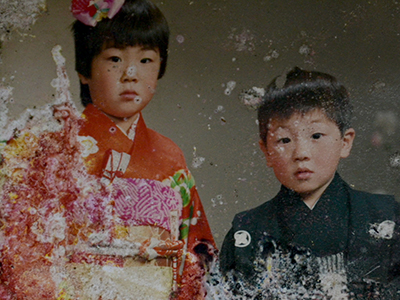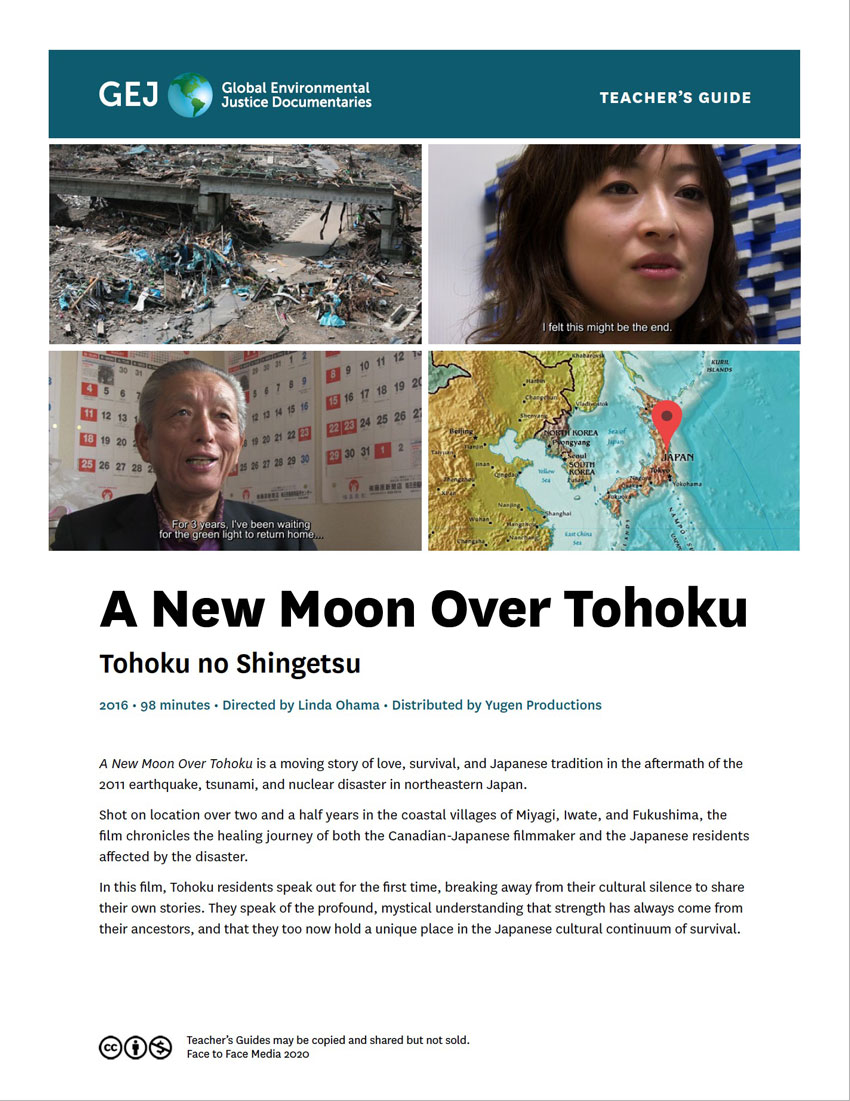A New Moon Over Tohoku
A New Moon Over Tohoku is a moving story of love, survival, and Japanese tradition in the aftermath of the 2011 earthquake, tsunami, and nuclear disaster in northeastern Japan. film chronicles the healing journey of both the Canadian-Japanese filmmaker and the Japanese residents affected by the disaster as Tohoku residents speak out for the first time, breaking away from their cultural silence to share their own stories.

Curator
Justine Wiesinger,Assistant Professor of Japanese at Bates College
This guide was co-written by Justine Wiesinger and Linda Ohama
Why I selected this film
The March 2011 disasters sit at the intersection of natural and manmade disaster, geographical histories of power (urban versus rural), and energy policy. This documentary offers a crucial lens on how individuals are affected by a cluster of interrelated disasters, presenting an appropriately complex picture of mourning, long-term impacts, and
differing tactics in living life after natural and nuclear disaster. As a researcher on the March 2011 disasters, I believe that it is extremely important to preserve the memories and testimonies of those who lived through the events. In a nuclear disaster particularly, human memory threatens to fade before the ecological and environmental effects of a meltdown do. This documentary is important because the filmmaker took time to invest herself sincerely in Tohoku before filmmaking began, and she prioritized the voices of its people.
Outside of Japan, centralized voices from Tokyo often end up speaking for the whole of Japan’s experience, but in the case of the 2011 disasters, it is essential to create opportunities for the people of Tohoku to speak their own truth and describe their experiences. Some of Ohama’s subjects share trauma expressed beyond words. Their stories benefit from the context of voice, expression, history, and the images of the survivors’ environment.
Shingetsu is a Japanese word meaning "new moon": the moon that cannot be seen, yet it still exists with all its power in the darkness of the night sky. In this film, voices from Miyagi, Iwate, and Fukushima speak out, breaking free from shadows of their cultural silence as they tell their stories.
Teacher's guide
Please see the teacher's guide for maps, background information, suggested subjects, questions and activities. The guide for this film was co-authored by Justine Wiesinger and the film's director, Linda Ohoam.
Suggested subject areas
Anthropology Geography, Asian Studies, East Asian Studies, History, Environmental Science, Political Science, Ethnography, Sociology, Film Studies
Synopsis
Shot on location over two and a half years in the coastal villages of Miyagi, Iwate, and Fukushima, the film chronicles the healing journey of both the Canadian-Japanese filmmaker and the Japanese residents affected by the disaster.
In this film, Tohoku residents speak out for the first time, breaking away from their cultural silence to share their own stories. They speak of the profound, mystical understanding that strength has always come from their ancestors, and that they too now hold a unique place in the Japanese cultural continuum of survival.
The environmental justice focus of the film
Tohoku, the northeastern region of Honshu (Japan’s largest island), has a fraught history in its relationship with urban centers of power in Japan, particularly Tokyo. Since the disasters, many have pointed to this history of an unequal relationship as underlying some of the disaster’s causes, consequences, and exacerbating factors. While Tohoku has long supplied a large portion of Japan’s rice and other agricultural products, labor from Tohoku has long been devalued. The result has been generations of its young people forced to seek work in Tokyo, leaving an aging and declining population further threatened by the disasters.
Because of Tohoku's relative poverty and its weakened civil society, subsidies and economic opportunities offered by the nuclear energy industry made the risk of hosting nuclear power plants more palatable to the region than it was to densely-populated and financially powerful urban centers. When Tohoku refugees encountered prejudice after the nuclear meltdown, many pointed out a grim irony: the power being generated at the Fukushima plants was not being used by Tohoku residents, but by those in Tokyo.
No reviews available.
Awards
“Tohoku no Shingetsu: A New Moon Over Tohoku”, was nominated for Best International Documentary at the Rome Independent Film Festival.
Citation
Main credits
Kusakari, Tamiyo (narrator)
Linda Ohama (film producer)
Linda Ohama (film director)
Linda Ohama (screenwriter)
Linda Ohama (editor of moving image work)
Linda Ohama (narrator)
Other credits
Director of photography, Kirk Tougas; music by Dennis Burke.
Distributor credits
Ohama,Linda
Ohama,Linda
Narrated by Tamiyo Kusakari
Music by Dennis Burke
Sound Design and editing Dennis Burke
Editorial Department
Kevin Reid on-line editor
Gary Shaw colorist
Tom Wu assistant editor
Matthew Shuttleworth on-line editor
Music Department
Dennis Burke music editor
Docuseek subjects
Asian History
Asian-American Studies
Civil Rights
Community
Cultural Anthropology
Documentary Films
Documentary Films
Energy
Environmental Anthropology
Environmental Law
Ethnography
Filmmaking
Government Policy
Human Rights
Immigration and Refugees
Nuclear Issues
Occupational Health and Safety
Oceans and Coasts
Political Geography
Pollution
Rural Studies
Women's Studies
Japan
Fishing Sector
Air
Habitat Destruction
Asian Studies
Environmental Justice
Environmental Justice
Rural Sociology
Toxic Waste
Distributor subjects
Keywords
Welcome to Docuseek2!
Docuseek2 is a streaming platform of the best documentary and social issue films available for the higher education community.
Anyone may search for titles and find detailed information about the titles. To preview films or license them for streaming, you must register and login.
Currently, we support online registration for anyone affiliated with a higher education institution. Please inquire if you are with a K-12 district or school or with a public library.
Click the Close button to get started!


